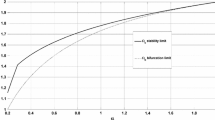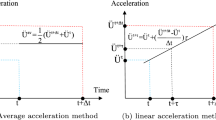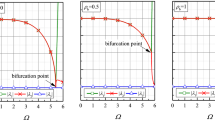Abstract
A novel second-order time integration algorithm for solving dynamic problems is presented. To demonstrate the abilities of this formulation, several linear and geometrical nonlinear structures are solved. The outcomes of authors’ technique are compared with the ones obtained by other researchers. The findings not only confirm the improved accuracy of the new scheme but also indicate that the suggested method remains stable when the trapezoidal rule fails to produce a stable solution. Effectively maximizing high-frequency numerical dissipation, without inducing excessive algorithmic damping in the important low-frequency region, is one of the proposed tactic merits. Spurious oscillations are removed, and small numerical dispersion error is achieved, when using this approach.































Similar content being viewed by others
References
Kuhl D, Crisfield MA (1999) Energy—conserving and decaying algorithms in non-linear structural dynamics. Int J Numer Methods Eng 45:569–599
Bathe KJ (2007) Conserving energy and momentum in nonlinear dynamics: a simple implicit time integration scheme. Comput Struct 85:437–445
Chang SY (2010) A new family of explicit methods for linear structural dynamics. Comput Struct 88:755–772
Chang SY (2014) A family of non-iterative integration methods with desired numerical dissipation. Int J Numer Methods Eng 100:62–86
Chang SY (2013) An explicit structure-dependent algorithm for pseudodynamic testing. Eng Struct 46:511–525
Kolay C, Ricles M (2014) Development of a family of unconditionally stable explicit direct integration algorithms with controllable numerical energy dissipation. Earthquake Eng Struct Dynam 43:1361–1380
Houbolt JC (1950) A recurrence matrix solution for the dynamic response of elastic aircraft. J Aeronaut Sci 17:540–550
Newmark NM (1959) A method of computation for structural dynamics. J Eng Mech Div (ASCE) 85(EM3):67–94
Wilson EL, Farhoomand I, Bathe KJ (1973) Nonlinear dynamic analysis of complex structures. Earthquake Eng Struct Dynam 1:241–252
Hilber HM, Hughes TJR, Taylor RL (1977) Improved numerical dissipation for time integration algorithms in structural dynamics. Earthquake Eng Struct Dynam 5:283–292
Wood WL, Bossak M, Zienkiewicz OC (1981) An alpha modification of Newmark’s method. Int J Numer Methods Eng 15:1562–1566
Bazzi G, Anderheggen E (1982) The ρ-family of algorithms for time-step integration with improved numerical dissipation. Earthquake Eng Struct Dynam 10:537–550
Chung J, Hulbert GM (1993) A time integration algorithm for structural dynamics with improved numerical dissipation: the generalized-α method. J Appl Mech Trans ASME 60:371–375
Hughes TJR (1987) The finite element method: linear static and dynamic finite element analysis. Prentice Hall, USA
Rezaiee-Pajand M, Alamatian J (2008) Implicit higher-order accuracy method for numerical integration in dynamic analysis. J Struct Eng (ASCE) 134(6):973–985
Idesman AV (2007) A new high-order accurate continuous Galerkin method for linear elastodynamics problems. Comput Mech 40:261–279
Rezaiee-Pajand M, Sarafrazi SR (2012) On the stability and accuracy of non-linear dynamic analysis using IHOA-m and PC-m families. Struct Build 165:455–471
Keierleber CW, Rosson BT (2005) Higher-order implicit dynamic time integration method. J Struct Eng (ASCE) 131(8):1267–1276
Rezaiee-Pajand M, Sarafrazi SR, Hashemian M (2011) Improving stability domains of the implicit higher order accuracy method. Int J Numer Methods Eng 88:880–896
Hulbert M, Chung J (1996) Explicit time integration algorithms for structural dynamics with optimal numerical dissipation. Comput Methods Appl Mech Eng 137:175–188
Rezaiee-Pajand M, Alamatian J (2008) Numerical time integration for dynamic analysis using a new higher order predictor–corrector method. Eng Comput 25(6):541–568
Soroushian A, Farjoodi J (2008) A unified starting procedure for the Houbolt method. Commun Numer Methods Eng 24:1–13
Ghassemieh M, Karimi-Rad M (2011) A parabolic acceleration time integration for dynamic problems. J Civil Survey Eng 45(1):35–43
Gholampour AA, Ghassemieh M, Karimi-Rad M (2013) A new unconditionally stable time integration method for analysis of nonlinear structural dynamics. J Appl Mech 80(2)
Bathe KJ, Baig MMI (2005) On a composite implicit time integration procedure for nonlinear dynamics. Comput Struct 83:2513–2524
Hughes TJR, Caughey TK, Liu WK (1978) Finite-element methods for nonlinear elastodynamics which conserve energy. J Appl Mech Trans ASME 45:366–370
Simo JC, Tarnow N (1992) The discrete energy momentum method. Conserving algorithms for nonlinear elasto-dynamics. J Appl Math Phys 43:757–792
Kuhl D, Ramm E (1996) Constraint energy momentum algorithm and its application to nonlinear dynamics of shells. Comput Methods Appl Mech Eng 136:293–315
Masuri SU, Hoitink A, Zhou X, Tamma KK (2009) Algorithms by design: a new normalized time-weighted residual methodology and design of a family of energy–momentum conserving algorithms for non-linear structural dynamics. Int J Numer Methods Eng 79:1094–1146
Gonzalez O (2000) Exact energy and momentum conserving algorithms for general models in nonlinear elasticity. Comput Methods Appl Mech Eng 190:1763–1783
Pimenta PM, Campello EMB, Wriggers P (2008) An exact conserving algorithm for nonlinear dynamics with rotational DOFs and general hyperelasticity. Part 1: rods. Comput Mech 42:715–732
Noh G, Bathe KJ (2013) An explicit time integration scheme for the analysis of wave propagations. Comput Struct 129:178–193
Dong S (2010) BDF-like methods for nonlinear dynamic analysis. J Comput Phys 229:3019–3045
Rezaiee-Pajand M, Sarafrazi SR (2010) A mixed and multi-step higher-order implicit time integration family. J Mech Eng Sci 224:2097–2108
Hoff C, Taylor RL (1990) Higher derivative explicit one step methods for nonlinear dynamic problems. Part I: design and theory. Int J Numer Methods Eng 29:275–290
Hoff C, Taylor RL (1990) Higher derivative explicit one step methods for nonlinear dynamic problems. Part II: practical calculations and comparison with other higher order methods. Int J Numer Methods Eng 29:291–301
Bathe KJ (1996) Finite element procedures. Prentice Hall, Englewood Cliffs
Wang MF, Au FTK (2009) On the precise integration methods based on Padé approximations. Comput Struct 87:380–390
Bathe KJ, Noh G (2012) Insight into an implicit time integration scheme for structural dynamics. Comput Struct 98:1–6
Goudreau GL, Taylor RL (1973) Evaluation of numerical methods in elastodynamics. Comput Methods Appl Mech Eng 2:69–97
KaiPing Y (2008) A new family of generalized-α time integration algorithms without overshoot for structural dynamics. Earthquake Eng Struct Dynam 37:1389–1409
Author information
Authors and Affiliations
Corresponding author
Appendix A: Coefficients
Appendix A: Coefficients
The amplification matrix for the proposed formulation has the following form:
where
Rights and permissions
About this article
Cite this article
Rezaiee-Pajand, M., Karimi-Rad, M. More accurate and stable time integration scheme. Engineering with Computers 31, 791–812 (2015). https://doi.org/10.1007/s00366-014-0390-x
Received:
Accepted:
Published:
Issue Date:
DOI: https://doi.org/10.1007/s00366-014-0390-x




